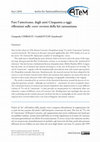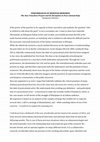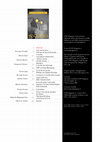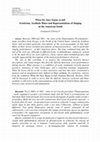interviews by Gianpaolo Chiriaco
Introduction to the symposium 'Black Vocality. Cultural Memories, Identities, and Practices of Af... more Introduction to the symposium 'Black Vocality. Cultural Memories, Identities, and Practices of African-American Singing Styles' on the Chicago Tribune
Papers by Gianpaolo Chiriaco

ATeM (Archives of Text and Music Studies), 2019
Since its first release in 1956, Renato Carosone's Neapolitan swing "Tu vuò fa' l'americano" has ... more Since its first release in 1956, Renato Carosone's Neapolitan swing "Tu vuò fa' l'americano" has been covered extensively. The interest in this piece increased significantly after 1999, thanks to its use in the movie The Talented Mr. Ripley and a number of 'interlinguistic' covers. This study aims at identifying the main elements, both in the lyrics and in the music of the original song, that generated this flow of alternative versions, as an attempt to discern the "patchwork of references" that has become a fundamental feature of popular music (Holm-Hudson 2002). It argues that the ironic use of national and cultural stereotypes is at the core of the process of covering "Tu vuò fa' l'americano", together with the fundamentally intercultural sonic and textual representation of a Neapolitan-wannabe-American. Simultaneously, the musical structure has been adopted by the covers as a sort of elastic structure from which each musician and composer can extract bits that are relevant to their artistic discourse while still retaining a recognizable relationship to the original. The article is introduced by an overview of the theoretical discussion around the process of covering that gravitates around-although not restricted to-taxonomies of covers in popular music. The central part focuses on musical and textual components that inspired artists to create different versions of "Tu vuò fa' l'americano". It then provides an interpretation of a substantial, albeit not exhaustive, corpus of different covers of Carosone's hit, dividing them into typologies that aim not only at pointing out the semiotic processes involved, but also at casting light on the reasons why this song has been covered within such a vast array of linguistic and stylistic contexts. Parlare di 'hit' nell'ambito della popular music comporta abitualmente la supposizione che si tratti di una canzone dal titolo e dall'interprete conosciuti da tanti. Nel caso di "Tu vuò fa' l'americano" di Renato Carosone, tale supposizione può essere confermata tutt'al più per un pubblico italiano, mentre fuori dall'Italia né il titolo napoletano né il nome di Carosone suscitano generalmente un effetto di riconoscimento. È invece sicuro che numerosi ascolta-tori ne riconoscono immediatamente la melodia e gli interventi dei fiati; molti altri possono affermare di aver ballato sui suoi ritmi nel corso degli ultimi vent'anni. È a partire dal 1999
This chapter is an ethnographic journey through the science and pedagogy of voice. It is a journe... more This chapter is an ethnographic journey through the science and pedagogy of voice. It is a journey that crosses two main paths: the world of vocalists and vocal pedagogues of African descent in Chicago, where I devoted two years of field research; and the community of singers, clinicians, speech therapists, and voice teachers that gravitate around the well-known “doctor of voice”, Franco Fussi, in Italy. Such community is nurtured and held together in a university master’s course based in Ravenna and directed by Dr. Fussi, titled Vocologia Artistica, where I was both a student (2014-15) and a teacher (2016-17)

Within the discussion about perception and interpretation of the black voice (Eidsheim, 2008; Leg... more Within the discussion about perception and interpretation of the black voice (Eidsheim, 2008; Legg, 2010; Sell, 2005), the distinct teaching method of Lena McLin (1928) emerges as particularly interesting.
Composer, choir director and voice teacher at Kenwood Academy, McLin is a pre-eminent figure in the black music scene of Chicago. The focus of this paper is on her vocal pedagogy, as it appears through her writing (McLin, 1970; 1972), and through interviews with her and her former students, Chicago-based vocalists. The practice of singing in a room where three of the four walls are covered with mirrors seems central in her teaching style. Triggered by questions from the teacher, about their bodies and their choices, singers are invited to look at, and recognize, their own self and wishes in the mirrors. She explains it as a practice “to become real,” where the search for his/her own voice requires the singer to look at his/her naked self (Smith, 2007).
But the room is also the space where students learn how to bring on stage “something familiar, the echo of the sound of the community” (Serra, 2011). McLin, in fact, emphasizes the importance of being aware of the experience of Blacks in America in order to sing. In her words, “singing is the expression of an internal feeling. But it is not just a feeling, it is a thought, a review of that particular situation that led to that feeling” (2013). Her method can be situated within the conceptualization offered by Griffin (2004), where the black singing body is positioned at the intersection of discourse about race and justice in the United States. Singers, regardless of the genre they perform, are invited to find their own voices and to find a motivation. Their singing style is therefore a result of the tension between the search for individuality and the expression of a black voice.
McLin’s teaching style will be finally enquired as a ritual, in which vocalists learn how to perform a sense of authenticity, that itself affirms and contests the social meaning of a black singing voice.

Talking about his “12 Years a slave,” director Steve McQueen stated that he just wanted to make a... more Talking about his “12 Years a slave,” director Steve McQueen stated that he just wanted to make a movie about slavery. And that the story – rather than about race – is about a human struggle. In other word, it is more like The Truce than Schindler’s List. As a result, his work opened up new directions for movies about slavery, through psychological explorations of the characters. This chapter aims to analyze how the singing voice is used to fulfill McQueen’s goals.
Central to the analysis is a comparison between two scenes, directed by McQueen, in which vocal performances are in the forefront: the interpretation of Roll Jordan Roll, by Chiwetel Ejiofor, and New York New York, sung by Carey Mulligan in “Shame.” In both scenes, different as they are, the singing voice articulates hope and frustrations related to the socio-geographical environment in which the characters live.
I will later focus on the significant presence of singing in “12 Years a Slave.” The book, quite surprisingly, contains just a single passage in which slaves sing. On the other hand, different vocal expressions (groans, humming, etc) have a remarkable position in describing the complexity of feelings of the field hands. By incorporating such vocal expressions in the songs (e.g. the humming of Petsy) the movie expands and confirms a myth of a black vocal attitude that presents, in the singing performance, a remarkable variety of sounds. Moreover, Steve McQueen repositions the distinctive black vocality in its original soundscape.
Pensato in primo luogo per studenti, Re: Sounds mette insieme suggerimenti, riflessioni, avvertim... more Pensato in primo luogo per studenti, Re: Sounds mette insieme suggerimenti, riflessioni, avvertimenti, proposte, indicazioni e consigli, da parte di alcuni tra i più importanti critici musicali ed esperti del settore. I suoi contenuti vanno intesi sia come una guida all'ascolto di alcuni pilastri della storia (e in alcuni casi dell'attualità) della popular music, sia come una guida all'orientamento professionale, per chi nel mondo della musica è intenzionato a costruirsi una carriera, un mestiere, o a coltivare un hobby.

2015 ICTM-Ireland annual conference, Dundalk - ABSTRACT: If the power of the past lies in its cap... more 2015 ICTM-Ireland annual conference, Dundalk - ABSTRACT: If the power of the past lies in its capacity to foster narratives and symbols, the question “who is entitled to talk about the past?” is not a secondary one. Gabriella Ghermandi, an Ethiopian-born storyteller and vocalist based in Bologna (Italy) who wrotes in Italian and sings in Amharic, articulates her works around the (removed) memory of the colonial experience of Italians in Ethiopia. Her book, ‘Regina di Fiori e di Perle’ (Queen of Flowers and Pearls, 2007) encountered a remarkable success. Ghermandi then founded the Atse Tewodros Project, a band composed by both Ethiopian and Italian musicians, whose CD was released in 2013. Together with the band, she mainly performs what she describes as “songs that Ethiopian partisans used to sing while preparing the battle against the fascist army.”
Drawing from a fieldwork of their last tour in Italy, the paper aims to show the complex strategy deployed by Ghermandi. While navigating two national identities, and through an elaborate – and yet problematic – performance of authenticity, she positions herself in the role of somebody who is not just entitled to talk about the colonial past, but also to embody it, with her voice, dance, and presence on stage.
This is the program of the second 'Black Vocality' symposium organized by the Center for Black Mu... more This is the program of the second 'Black Vocality' symposium organized by the Center for Black Music Research at Columbia College, Chicago, 2014 November 18-19
This is the program of the 'Black Vocality' symposium, organized by the Center for Black Music Re... more This is the program of the 'Black Vocality' symposium, organized by the Center for Black Music Research at Columbia College, 2013 September 24-25
In “Filling the Space: Field Hollers and the Social Role of Singing in African-American Communiti... more In “Filling the Space: Field Hollers and the Social Role of Singing in African-American Communities,” I investigate and place this form of vocal expression into a symbolic, contextualized and melismatic frame, revealing hollers as a “vocal style” rather than a crystallized musical form. As such, the analysis demonstrates how the practice of hollering, within African- American communities, served as both a means of communication and a tool for individual expression and achievement.
Ideas and practices from African-American literary discourse, poetry and prose, and musicological philosophy are utilized in this ethnomusicological investigation. Sources include contemporary scholars Kay Kaufman Shelemay, Kamau Braithwaite, Jean-Luc Nancy, Walter Ong, Carlo Serra, Jacques Deridda, and others.

Partendo dalla provocazione inserita nel titolo – nel tentativo di rispondere alla domanda “esist... more Partendo dalla provocazione inserita nel titolo – nel tentativo di rispondere alla domanda “esiste un ascolto non innocente?” – prendo in considerazione le barriere e i filtri culturali che intervengono nell’ascolto della voce umana, e in particolare della voce cantata. Lo spunto iniziale proviene da un caso di cronaca legato al celebre disco di Paul Simon, Graceland, di cui nel 2012 ricorre il venticinquesimo anno dalla nascita (celebrato con un documentario e una reunion). Dalla controversa relazione fra quel disco e la lotta anti-apartheid, la riflessione si sposta lungo le direttrici tracciate da pensatori quali Deridda e Barthes e da performer quali Demetrio Stratos, che tendono a unire – ma allo stesso tempo separano – il significato di un messaggio vocale e il suo significante (la sua vocalità). La tesi finale suggerita è che, pur non esistendo un ascolto non innocente, l’ascolto di una voce cantata può evolversi storicamente, e può arricchirsi proprio in virtù del riconoscimento delle sottili direttrici affrontate e descritte nel testo.
Journal Articles by Gianpaolo Chiriaco

Between 1800 and 1863-the years of the Emancipation Proclamation-many travellers from Europe or t... more Between 1800 and 1863-the years of the Emancipation Proclamation-many travellers from Europe or the North of the United States visited the Southern States and provided particular descriptions of the socio-geographic of that land. Many of their stories included descriptions of musical practices-and in particular singing performances-of Afro American slaves. The trips continued long after the end of the civil war, although in different forms. A philanthropic endeavour seemed to be the main driver for such explorers, whose reports often included pictures that visually supported the descriptions of the musical performances observed. The aim of this contribute is to analyze the relationship between literary descriptions and visual images that describe African-American vocal performances during slavery. What emerges is a conflation of exotic sentiments towards musical practices, memories of sonic landscapes, and a somewhat nostalgic imagination. Then, the focus will be on the ex-slave narratives and how they have constructed a memory and an imagination later defined as blues aesthetic. In conclusion, extracts from the exhibition When the Stars Begin to Fall (Studium Museum, Harlem, 2014) will be discussed in order to prove that the dialectic between exoticism and blues aesthetic is still active in the representations of the South of Uniterd States that move between sonic memories and imagination. Riassunto. Tra il 1800 e il 1863-anno in cui Lincoln proclamò l'Emancipazione-molti viaggiatori europei o provenienti dagli stati del Nord si avventurarono nel Sud degli Stati Uniti fornendo descrizioni particolareggiate di quella realtà sociale e geografica. Molti dei loro racconti contenevano descrizioni di pratiche musicali-e in particolare di canti-di afroamericani costretti in schiavitù. I viaggi continuarono anche dopo la fine della guerra civile e per tutto l'Ottocento, sebbene in forme differenti. Una spinta filantropica emerge come il motore principale di tali esplorazioni, i cui resoconti consegnati alle stampe possedevano spesso un apparato iconografico che supportava visivamente le descrizioni delle performances vocali osservate da questi viaggiatori. Questo contributo ha lo scopo di analizzare il rapporto tra descrizioni letterarie e visuali delle performances musicali di afroamericani in schiavitù. Ne emerge un quadro articolato in cui si fondono l'esotizzazione delle pratiche musicali, le memorie di paesaggi sonori, e un'immaginazione ontrisa di nostalgia.
Is it possible to define the relationship between the sound of a singing voice and the memory of ... more Is it possible to define the relationship between the sound of a singing voice and the memory of that voice? The history of African-American music and African-American culture is here analyzed using this question as a key to interpretation. What emerges is a picture where the singing voice is deemed as a founding myth. A myth that is nevertheless intertwined with the history of body and of identity. Cultural history, ethnomusicology, voice studies, philosophy of voice and language are incorporated here in one methodological approach. While crossing the symbolism related to the black singing voice, the relationship among memory and historical sources as well as conflicts between cultural memory and racial imagination, the investigation eventually explores the intersections between tradition and cultural identity in the work of contemporary vocalists.

“Expressing Africas: Analysis of Artistic Practices Related to African Diasporas within a Postcol... more “Expressing Africas: Analysis of Artistic Practices Related to African Diasporas within a Postcolonial Context” is the title of a research project designed by a collective of young scholars from various disciplinary areas. The research looks at the ways in which the Afro-Mediterranean migrant imagination is expressed in Italy through artistic practices such as literature, music, and the visual and performance arts.
The study on migration from sub-Saharan Africa and the Maghreb has only recently profited from a new attention to the cultural expressions that embody the hopes and ordeals embedded in these global flows, shaping ever-changing aesthetic universes. The analysis of the African diaspora through related creative practices, from the present as well as from the past, demands to recognize how migration contributes to the elaboration of Italian identity as well as to its deconstruction as an authoritative discourse in the socio-political debate. The archive collecting these practices will necessarily be ‘future’ or ‘living’, as Arjun Appadurai writes, but also ex post, witnessing and interpreting the role that writers, musicians and artists already play in the media and within the academy.
This paper will use Gabriella Ghermandi’s work as a case study. The author of a well-known novel titled Regina di fiori e di perle (2007), Ghermandi has recently oriented her practices to musical performances. Since 2013, she has been singing, together with her Atse Tewodros Project, what she defines as “songs Ethiopian partisans sang while marching to fight against the Fascist army.” Through an analysis of the audio-visual documentation of one of her 2014 concerts, our contribution will focus on how her performance embodies a “cultural transit of the present,” working at the same time as re-memory of a removed past and practice of a democratic cohabitation ‘to come’. Ghermandi’s performing body is part of a future archive of migrant performances and performativities, but it also works as an archive of bodily, vocal and visual memories of colonial Italy, standing at the very crossroads between postcolonial criticism and artistic practices that ExPost aspires to map out.
Books by Gianpaolo Chiriaco

Copertina, indice, introduzione e manifesto del volume collettaneo di ricercatori attivisti del p... more Copertina, indice, introduzione e manifesto del volume collettaneo di ricercatori attivisti del progetto "S/Murare il Mediterraneo. Pratiche locali, nazionali e transfrontaliere di artivismo transculturale, per una poetica e politica dell'ospitalità e mobilità".Contiene saggio "Mediterraneo liquido, Per un pensiero liquido decoloniale", di Paola Zaccaria, accessibile nella mia pagina academia, dove sono scaricati anche saggi correlati al progetto "S/MUrare il Mediterraneo/Un-walling the Mediterranean": "Erranze senza ritorni. Strade d'acqua ... liquefazione dell'appartenenza", "Gli archivi incarnati del Mediterraneo", "(Trans)MediterrAtlantic embodied shadow archives"; "MEDITERRANEAN AND TRANSATLANTIC ARTIVISM: COUNTER-ACTING NEO-COLONIALISMS IN THE PUBLIC SPHERE"; "Medi-terranean Borderization, or deterritorializing Mediterranean space".
ENGLISH:
Cover, contents, introduction and manifesto of the volume written by the activist researchers of the project "Un/Walling the Mediterranean", Bari, 2009-16. SEE ALSO RELATED PAPERS ON UN/WALLING THE MEDITERRANEAN uploaded by Paola Zaccaria on her academia page.











Uploads
interviews by Gianpaolo Chiriaco
Papers by Gianpaolo Chiriaco
Composer, choir director and voice teacher at Kenwood Academy, McLin is a pre-eminent figure in the black music scene of Chicago. The focus of this paper is on her vocal pedagogy, as it appears through her writing (McLin, 1970; 1972), and through interviews with her and her former students, Chicago-based vocalists. The practice of singing in a room where three of the four walls are covered with mirrors seems central in her teaching style. Triggered by questions from the teacher, about their bodies and their choices, singers are invited to look at, and recognize, their own self and wishes in the mirrors. She explains it as a practice “to become real,” where the search for his/her own voice requires the singer to look at his/her naked self (Smith, 2007).
But the room is also the space where students learn how to bring on stage “something familiar, the echo of the sound of the community” (Serra, 2011). McLin, in fact, emphasizes the importance of being aware of the experience of Blacks in America in order to sing. In her words, “singing is the expression of an internal feeling. But it is not just a feeling, it is a thought, a review of that particular situation that led to that feeling” (2013). Her method can be situated within the conceptualization offered by Griffin (2004), where the black singing body is positioned at the intersection of discourse about race and justice in the United States. Singers, regardless of the genre they perform, are invited to find their own voices and to find a motivation. Their singing style is therefore a result of the tension between the search for individuality and the expression of a black voice.
McLin’s teaching style will be finally enquired as a ritual, in which vocalists learn how to perform a sense of authenticity, that itself affirms and contests the social meaning of a black singing voice.
Central to the analysis is a comparison between two scenes, directed by McQueen, in which vocal performances are in the forefront: the interpretation of Roll Jordan Roll, by Chiwetel Ejiofor, and New York New York, sung by Carey Mulligan in “Shame.” In both scenes, different as they are, the singing voice articulates hope and frustrations related to the socio-geographical environment in which the characters live.
I will later focus on the significant presence of singing in “12 Years a Slave.” The book, quite surprisingly, contains just a single passage in which slaves sing. On the other hand, different vocal expressions (groans, humming, etc) have a remarkable position in describing the complexity of feelings of the field hands. By incorporating such vocal expressions in the songs (e.g. the humming of Petsy) the movie expands and confirms a myth of a black vocal attitude that presents, in the singing performance, a remarkable variety of sounds. Moreover, Steve McQueen repositions the distinctive black vocality in its original soundscape.
Drawing from a fieldwork of their last tour in Italy, the paper aims to show the complex strategy deployed by Ghermandi. While navigating two national identities, and through an elaborate – and yet problematic – performance of authenticity, she positions herself in the role of somebody who is not just entitled to talk about the colonial past, but also to embody it, with her voice, dance, and presence on stage.
Ideas and practices from African-American literary discourse, poetry and prose, and musicological philosophy are utilized in this ethnomusicological investigation. Sources include contemporary scholars Kay Kaufman Shelemay, Kamau Braithwaite, Jean-Luc Nancy, Walter Ong, Carlo Serra, Jacques Deridda, and others.
Journal Articles by Gianpaolo Chiriaco
The study on migration from sub-Saharan Africa and the Maghreb has only recently profited from a new attention to the cultural expressions that embody the hopes and ordeals embedded in these global flows, shaping ever-changing aesthetic universes. The analysis of the African diaspora through related creative practices, from the present as well as from the past, demands to recognize how migration contributes to the elaboration of Italian identity as well as to its deconstruction as an authoritative discourse in the socio-political debate. The archive collecting these practices will necessarily be ‘future’ or ‘living’, as Arjun Appadurai writes, but also ex post, witnessing and interpreting the role that writers, musicians and artists already play in the media and within the academy.
This paper will use Gabriella Ghermandi’s work as a case study. The author of a well-known novel titled Regina di fiori e di perle (2007), Ghermandi has recently oriented her practices to musical performances. Since 2013, she has been singing, together with her Atse Tewodros Project, what she defines as “songs Ethiopian partisans sang while marching to fight against the Fascist army.” Through an analysis of the audio-visual documentation of one of her 2014 concerts, our contribution will focus on how her performance embodies a “cultural transit of the present,” working at the same time as re-memory of a removed past and practice of a democratic cohabitation ‘to come’. Ghermandi’s performing body is part of a future archive of migrant performances and performativities, but it also works as an archive of bodily, vocal and visual memories of colonial Italy, standing at the very crossroads between postcolonial criticism and artistic practices that ExPost aspires to map out.
Books by Gianpaolo Chiriaco
ENGLISH:
Cover, contents, introduction and manifesto of the volume written by the activist researchers of the project "Un/Walling the Mediterranean", Bari, 2009-16. SEE ALSO RELATED PAPERS ON UN/WALLING THE MEDITERRANEAN uploaded by Paola Zaccaria on her academia page.
Composer, choir director and voice teacher at Kenwood Academy, McLin is a pre-eminent figure in the black music scene of Chicago. The focus of this paper is on her vocal pedagogy, as it appears through her writing (McLin, 1970; 1972), and through interviews with her and her former students, Chicago-based vocalists. The practice of singing in a room where three of the four walls are covered with mirrors seems central in her teaching style. Triggered by questions from the teacher, about their bodies and their choices, singers are invited to look at, and recognize, their own self and wishes in the mirrors. She explains it as a practice “to become real,” where the search for his/her own voice requires the singer to look at his/her naked self (Smith, 2007).
But the room is also the space where students learn how to bring on stage “something familiar, the echo of the sound of the community” (Serra, 2011). McLin, in fact, emphasizes the importance of being aware of the experience of Blacks in America in order to sing. In her words, “singing is the expression of an internal feeling. But it is not just a feeling, it is a thought, a review of that particular situation that led to that feeling” (2013). Her method can be situated within the conceptualization offered by Griffin (2004), where the black singing body is positioned at the intersection of discourse about race and justice in the United States. Singers, regardless of the genre they perform, are invited to find their own voices and to find a motivation. Their singing style is therefore a result of the tension between the search for individuality and the expression of a black voice.
McLin’s teaching style will be finally enquired as a ritual, in which vocalists learn how to perform a sense of authenticity, that itself affirms and contests the social meaning of a black singing voice.
Central to the analysis is a comparison between two scenes, directed by McQueen, in which vocal performances are in the forefront: the interpretation of Roll Jordan Roll, by Chiwetel Ejiofor, and New York New York, sung by Carey Mulligan in “Shame.” In both scenes, different as they are, the singing voice articulates hope and frustrations related to the socio-geographical environment in which the characters live.
I will later focus on the significant presence of singing in “12 Years a Slave.” The book, quite surprisingly, contains just a single passage in which slaves sing. On the other hand, different vocal expressions (groans, humming, etc) have a remarkable position in describing the complexity of feelings of the field hands. By incorporating such vocal expressions in the songs (e.g. the humming of Petsy) the movie expands and confirms a myth of a black vocal attitude that presents, in the singing performance, a remarkable variety of sounds. Moreover, Steve McQueen repositions the distinctive black vocality in its original soundscape.
Drawing from a fieldwork of their last tour in Italy, the paper aims to show the complex strategy deployed by Ghermandi. While navigating two national identities, and through an elaborate – and yet problematic – performance of authenticity, she positions herself in the role of somebody who is not just entitled to talk about the colonial past, but also to embody it, with her voice, dance, and presence on stage.
Ideas and practices from African-American literary discourse, poetry and prose, and musicological philosophy are utilized in this ethnomusicological investigation. Sources include contemporary scholars Kay Kaufman Shelemay, Kamau Braithwaite, Jean-Luc Nancy, Walter Ong, Carlo Serra, Jacques Deridda, and others.
The study on migration from sub-Saharan Africa and the Maghreb has only recently profited from a new attention to the cultural expressions that embody the hopes and ordeals embedded in these global flows, shaping ever-changing aesthetic universes. The analysis of the African diaspora through related creative practices, from the present as well as from the past, demands to recognize how migration contributes to the elaboration of Italian identity as well as to its deconstruction as an authoritative discourse in the socio-political debate. The archive collecting these practices will necessarily be ‘future’ or ‘living’, as Arjun Appadurai writes, but also ex post, witnessing and interpreting the role that writers, musicians and artists already play in the media and within the academy.
This paper will use Gabriella Ghermandi’s work as a case study. The author of a well-known novel titled Regina di fiori e di perle (2007), Ghermandi has recently oriented her practices to musical performances. Since 2013, she has been singing, together with her Atse Tewodros Project, what she defines as “songs Ethiopian partisans sang while marching to fight against the Fascist army.” Through an analysis of the audio-visual documentation of one of her 2014 concerts, our contribution will focus on how her performance embodies a “cultural transit of the present,” working at the same time as re-memory of a removed past and practice of a democratic cohabitation ‘to come’. Ghermandi’s performing body is part of a future archive of migrant performances and performativities, but it also works as an archive of bodily, vocal and visual memories of colonial Italy, standing at the very crossroads between postcolonial criticism and artistic practices that ExPost aspires to map out.
ENGLISH:
Cover, contents, introduction and manifesto of the volume written by the activist researchers of the project "Un/Walling the Mediterranean", Bari, 2009-16. SEE ALSO RELATED PAPERS ON UN/WALLING THE MEDITERRANEAN uploaded by Paola Zaccaria on her academia page.